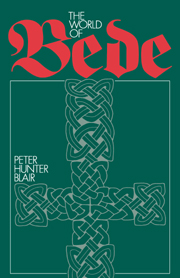Book contents
- Frontmatter
- Contents
- Foreword by Michael Lapidge
- Preface
- List of Abbreviations
- PART ONE ALTER ORBIS
- PART TWO TOWARDS CHRISTIANITY
- 5 The Initiation of a Mission
- 6 The Journey to England
- 7 Gregory's English Correspondence
- 8 Bede's Account of the Mission
- 9 The First Archbishops of Canterbury
- 10 Paulinus in Northumbria
- 11 ‘Celtic’ and ‘Roman’ Missionaries
- PART THREE THE GROWTH OF MONASTICISM
- PART FOUR LEARNING, TEACHING AND WRITING
- Select Bibliography
- Index
5 - The Initiation of a Mission
Published online by Cambridge University Press: 02 February 2010
- Frontmatter
- Contents
- Foreword by Michael Lapidge
- Preface
- List of Abbreviations
- PART ONE ALTER ORBIS
- PART TWO TOWARDS CHRISTIANITY
- 5 The Initiation of a Mission
- 6 The Journey to England
- 7 Gregory's English Correspondence
- 8 Bede's Account of the Mission
- 9 The First Archbishops of Canterbury
- 10 Paulinus in Northumbria
- 11 ‘Celtic’ and ‘Roman’ Missionaries
- PART THREE THE GROWTH OF MONASTICISM
- PART FOUR LEARNING, TEACHING AND WRITING
- Select Bibliography
- Index
Summary
There is no episode in the history of the English in Britain of a significance comparable with the mission of St Augustine about which we can learn so little from contemporary written sources. The contemporary evidence amounts only to some thirty letters written by Gregory, and many of these are mere letters of commendation to bishops and lay rulers through whose lands the travellers were expected to pass. The account of Gregory's tenure of the papacy in the Liber Pontificalis contains only a short reference to the mission. There are no surviving letters written by Augustine or any of his companions, nor by any of the bishops whom they will have met on their journey from Rome to England. A sixth-century copy of the Gospels of Mediterranean origin is associated with St Augustine by good tradition and is likely to have been in use in Canterbury in Augustine's time. Apart from a code of law, now preserved only in a twelfth-century manuscript but believed to be a genuine code issued by Æthelbert c. 602, there are no other Canterbury records of any kind dating from the period of the mission itself. There are several forged charters purporting to belong to the reign of Æthelbert, but the oldest unquestionably genuine Kentish charter belongs to the time of archbishop Theodore who did not reach England until more than sixty years after Augustine's death.
- Type
- Chapter
- Information
- The World of Bede , pp. 41 - 48Publisher: Cambridge University PressPrint publication year: 1990



